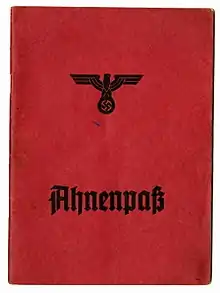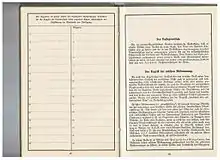Aryan certificate
In Nazi Germany, the Aryan certificate/passport (German: Ariernachweis) was a document which certified that a person was a member of the presumed Aryan race. Beginning in April 1933, it was required from all employees and officials in the public sector, including education, according to the Law for the Restoration of the Professional Civil Service. It was also a primary requirement to become a Reich citizen for those who were of German or related blood (Aryan) and wanted to become Reich citizens after the Nuremberg Laws were passed in 1935. A "Swede or an Englishman, a Frenchman or Czech, a Pole or Italian" was considered to be related, that is, "Aryan".[1][2][3]




There were two main types:
- Kleiner Ariernachweis (Lesser Aryan certificate) was one of:
- Seven birth or baptism certificates (or a combination of both) (the person, his parents and grandparents) and three marriage certificates (parents and grandparents) or certified proofs thereof:
- Ahnenpaß (literally ancestor's passport)
- Ahnentafel, a certified genealogy table
- Seven birth or baptism certificates (or a combination of both) (the person, his parents and grandparents) and three marriage certificates (parents and grandparents) or certified proofs thereof:
- Großer Ariernachweis (Greater Aryan certificate) was required for compliance with the requirements of the Reichserbhofgesetz (land heritage law) and membership in the Nazi party. This certificate had to trace the family pedigree down to 1800 (to 1750 for SS officers). According to the especially strict regulation of this law which included the goal of "Preserving the Purity of German Blood,"[4] the only eligible were those who could prove (reaching back to January 1, 1800) that "none of their paternal nor their maternal ancestors had Jewish or colored blood".[5]
Legal relevance today
Like other documents issued by public authorities at the time, the Aryan certificate was an official government document. As such, it still has evidentiary value in legal proceedings today, similar to how an expired East German passport can be used to support a claim of German citizenship.[6]
See also
References
- Cornelia Schmitz-Berning, Vokabular des Nationalsozialismus, p. 61 (German)
- Horst Seidler, Andreas Rett, Das Reichssippenamt entscheidet: Rassenbiologie im Nationalsozialismus, p. 97 (German)
- Arischer Abstammung (deutschblütig) ist demnach derjenige Mensch, der frei von einem, vom deutschen Volke aus gesehen, fremdrassigen Blutseinschlage ist. Als fremd gilt hier vor allem das Blut der auch im europäischen Siedlungsraume lebenden Juden und Zigeuner, das der asiatischen und afrikanischen Rassen und der Ureinwohner Australiens und Amerikas (Indianer), während z.B. ein Engländer oder Schwede, ein Franzose oder Tscheche, ein Pole oder Italiener, wenn er selbst frei von solchen, auch ihm fremden Blutseinschlägen ist, als verwandt, also als arisch gelten muß, mag er nun in seiner Heimat oder in Ostasien oder in Amerika wohnen oder mag er Bürger der U.S.A. oder eines südamerikanischen Freistaates sein. (in German)
- Quotation in German: "Reinhaltung des deutschen Blutes"; in: Isabel Heinemann. Rasse, Siedlung, deutsches Blut, Wallstein Verlag, 1999, ISBN 3-89244-623-7, p. 54
- Quotation in German: "wer unter seinen Vorfahren väterlicherseits oder mütterlicherseits kein jüdisches oder farbiges Blut hat"; in: Isabel Heinemann. Rasse, Siedlung, deutsches Blut, Wallstein Verlag, 1999, ISBN 3-89244-623-7, p. 54
- "Staatsangehörigkeitsausweis". Ilm-Kreis. Archived from the original on 2018-07-08. Retrieved 9 June 2023.
- Nicholas John Fogg, 'German genealogy during the Nazi period (1933-1945)', in Genealogists' Magazine, vol. 30, no. 9 (London: March 2012) pages 347–362.